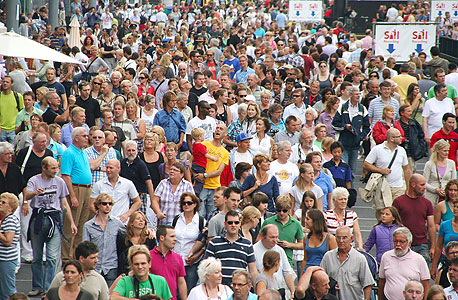Israel's Startup Nation was born in caveman times
Coronavirus? Economic crisis? For Oded Galor, one of the world’s most senior economists, these are just footnotes in the pages of history. In a brilliant new book he explains how geography made Scandavians calculated, why diversity is constructive in the U.S. but destructive in Syria, and why the last 200 years have been humanity’s best
What keeps those cogs moving?
“Geographic surroundings and human diversity. When we examine the growth and development of certain cultures, democracy, and efficient economic and political institutions provide only a portion of the explanation. Geography provides another: conditions in this area of the world have contributed to establishing certain failures — for example, people's willingness to delay gratification and invest in the future.”
 Oded Galor in his home. Photo: Courtesy
Oded Galor in his home. Photo: Courtesy What does geography have to do with delayed gratification?
“Consider agriculture: in Europe and Southeast Asia, crop yield is twice as large as in Africa. In Europe, the waiting time between planting and harvesting is one third shorter than in Africa. Therefore, the daily return on investment in agriculture in Africa is 60% lower than in Europe and Asia.
“For that reason, people living there had a reduced incentive to invest and learn how to delay gratification. Delaying gratifications, however, is an essential element of growth: in order to grow, you have to invest. If the geographical conditions impair this ability, people tend to invest less in human capital, physical capital, and technology — even if they are exposed to the same economic incentives,” Galor said.
Galor knows a thing or two about growth and incentives. He is a professor of economics at the Ivy League Brown University. He is part of a wave of Israeli economists who went to work in elite U.S. universities throughout the 1990s (though he remained a fellow in the Economic departments of Tel Aviv University and the Hebrew University of Jerusalem). Even among that illustrious list, Galor stands out as one of the most quoted, primarily due to the unified growth theory that he created and which aspires to lay out the principles that explain economic development over the entire course of human history.
This theory is the axis around which Galor weaves his new and remarkably accessible book ‘The Journey of Humanity: Roots of Global Inequality’ (co-authored by Ori Katz) and particularly its two central questions: why is it that throughout most of human history the standard of living held uniform, until the last 200 years during which it multiplied seventeenfold? And why is it during this period in particular that such huge gaps developed between countries, with some of them racing ahead?
Two-hundred years ago, domestic product per capita in Western Europe, the world's most developed region, was three times higher than that of sub-Saharan Africa, the most deprived region. Today this gap has grown to 50 times higher, a "civilization bang," as Galor puts it.
“Most of these gaps are the result of ancient historical elements: some of them were set some 500 years ago, at a time when many of the world's countries were conquered by the imperial powers, but other elements date much earlier, to the agricultural revolution ten thousand years ago, and some are even earlier, during modern humans’ departure from Africa."
 The age of discovery. Photo: Shutterstock
The age of discovery. Photo: Shutterstock Will these gaps ever close?
“One can expect that over time, poor countries will adopt institutions that contribute to economic growth, and people in those countries will adopt cultural elements that contribute to personal prosperity. It may also be assumed that technological improvements will reduce the impact of geography on economic growth: technology will compensate for the fact that some places, such as Bolivia, have had an inhibiting effect because they are cut off from the sea. But in both cases, it will take many years to overcome such failures, which originate deep in the past. Therefore, I do not anticipate huge leaps but rather that the gaps slowly close over time. Inequality will gradually decrease. But it will stay with us for a long time."
Why Mediterranean people tend to take more risks
Environmental impact, Galor argues, is not only cultural but also burned into the actual genes, thus preserving itself for vast periods of time — which explains why some countries remains largely disadvantaged, even though large parts of it enjoy access to modern agriculture.
“In certain regions, natural selection will lean towards people who have the ability to delay gratification. It is true that there is a process of adjustment to the modern situation, but it is slow. Consider second-generation immigrants to Germany — people who were born there, and had access to the same education system. It turns out that the ability to delay gratification is higher among people whose families come from places where agricultural yield is higher" Galor said.
If a poor climate for agriculture produces people who have difficulty in delaying gratification, how do you explain the position of the southern European states, like Spain, Italy, and Greece? They enjoy a comfortable climate but trail behind their cold and calculated neighbors to the north from an economic standpoint.
“In the book, we explain that it has more to do with ‘hatred of losing’— a person’s willingness to take on risks even at the cost of failure. We found that historically speaking the more comfortable the weather in a certain region is, and in turn the better the agricultural yields are, the more the local inhabitants tend to be risk-takers,” Galor explained.
“People who live in regions that exhibit unstable climate develop anxiety from climatic volatility: in the case of better-than-average years, the benefit of food supplementation is marginal, but poor years can lead to genuine extinction. Therefore in volatile areas, natural selection, both biological and cultural, evolved people that tend to be more risk-averse, economically too,” Galor said.
You took great care in the book when touching on genetic diversity
“It really is a sensitive topic. In our attempt to understand the process of growth, we do not to lean on genetic differences among societies. Our claim is that the differences are caused by the makeup of the population. Meaning, it’s not about individual traits, but rather on ‘who your neighbors are,’ how different am I from you and you from I? When it comes to any trait, the question is what is the diversion from the average? In certain countries, the dispersal is higher than others.
 A large crowd of people. Photo: Shutterstock
A large crowd of people. Photo: Shutterstock
When human diversity diminishes, stability leads to stagnation
Human diversity is another factor that influences the growth and development of cultures, according to Galor. “Human diversity was created during human kind’s departure from Africa, they didn’t simply get up and start to wander. Out of the immense diversity that existed in Africa, there were certain groups, apparently marginal and genetically different to some extent, that were pressured to migrate for various reasons. Those groups settled on the outskirts of Africa, in the Middle East. And thus it proceeded: every time a portion of the population migrated to the next stop. As the distance from Africa grew, human diversity decreased. The last stop on these migration routes was South America, which is why it exhibits the least amount of diversity.
“Human diversity has contradicting impacts. On one hand, very diverse countries are characterized by a lack of social cohesion, mutual distrust, and frequent civil wars. Many African states offer up good examples of this. On the other, diverse countries exhibit high levels of cross-fertilization that can increase the rate of technological improvements,” Galor said.
Societies where there is little diversity may enjoy stability, but they suffer from stagnation because there is little cross-fertilization, which causes them to develop more slowly.
“To illustrate the point, take the example of East and West Germany: a certain region can rapidly change its regime and shift to a new mode of development, but it is still the same people, with fundamental cultural similarities in a similar geographic location. In Africa, human diversity is very wide, to a degree that it leads to civil war and lack of social cohesion.
“Between the two extremes, there is a balance point where positive and negative influences reach equilibrium and where optimal diversity contributes to productivity. Nowadays this is happening in the U.S. for example,” Galor explained.
In today’s migrant-dominated world, in which people move all over the place, do prehistoric associations still have meaning?
“The role of the groups is still relevant. But in immigration countries like the U.S., there is a balance between populations that are too diverse and populations that are not diverse enough. It exemplifies how important the role of education is as a stabilizing factor— and not only in immigration states but also in the origin countries. Africa, for example, can benefit from reducing the costs of human diversity by educating for tolerance. American society, which was exceptionally racist until the middle of the 20th century, went through an exceptional process of change when it comes to the society’s ability to accept different people.
“In places like Bolivia, which suffer from the opposite affliction of too little diversity, the goal is to create more openness to differences and critical thinking. It requires us to alter our attitudes: The World Bank, for example, promotes investment in education, but measures it in terms of the number of years in the system and not the quality of the content being taught. That is a mistake,” Galor argues.
“Israel has reached a point in which its vigor is properly channeled”
All of these variables eventually form the fates of civilizations, and the winner in this race towards growth is the Western culture, the one that developed out of Europe. “Several reasons for that have been proposed,” Galor details: “One of the central explanations addresses the division of the continent into many peoples and countries over the course of history, which in turn drove political and technological competition that led to innovation. Take Christopher Columbus for example. He sailed America while on a mission by the King of Spain, even though he himself was Italian, and he only did so after Portugal first rejected his proposal to find a new trade route to India. On the other hand, China is more homogenous, resulting in a central government that depressed technological innovation. That’s why China, which was a developed culture, at one stage stagnated.
“My explanation is a little different. In my opinion, Europe’s progression was slowed by a sequence of dominant cultures that transposed one another — first Greece, then Rome, then other civilizations. one and two thousand years ago China was ahead of Europe. Then 200 years ago, when the world managed to break free from the technological stagnation which had characterized it, suddenly Europe’s human diversity gave it an edge that allowed it to leap into the age of enlightenment and the technological revolution,” Galor said.
 The Roman Colosseum. Photo: David Cohen
The Roman Colosseum. Photo: David Cohen What can be determined about Israeli society in this regard?
“Like other Middle Eastern societies, it is one of the most diverse societies outside of Africa. On a scale of 0 to 1, human diversity in Israel stands at 0.73, compared to 0.77 in Africa, 0.73 in Europe and 0.63 in Bolivia.
“Studies show a link between the people who live in Israel today and those who lived there during biblical times. In the past that diversity caused problems in the forms of many internal battles, similarly to what we see today in Syria, which displays a diversity level similar to that of Israel,” Galor said.
Israel has no shortage of internal conflicts, but they do not cripple the country.
“Perhaps the fact that it is surrounded by enemies allows Israeli society to overcome lack of cohesion,” Galor proposed.
 An Israeli soldier protects an Iron Dome battery. Photo: Amit Shaal
An Israeli soldier protects an Iron Dome battery. Photo: Amit Shaal What about Israelis’ ability to delay gratification?
“The types of crops that were prevalent in this part of the world are definitely of the sort that encouraged delayed gratification and I believe that is something that characterizes Israeli society to this day, especially as it relates to long term development and investment in human capital. This diversity can have an impact in several ways, but it seems like Israel has reached a point in which its vigor is being channeled correctly. One could say that the startup nation was born in the cavemen days,” Galor said.
“In the short term Covid-19 will harm the developing world”
In the book you mention the “Black Death,” the plague that hit Europe in the middle ages, as a factor that contributed to reducing gaps in European society. Where do you think the current pandemic will take us?
“It may have negative consequences. Taking it back to delayed gratification: that ability rests on our certainty in our ability to survive. Now, for the first time in ages, we are treating our life expectancy as something that is less certain: those who never gave it a second thought, are suddenly asking themselves ’will I live to see tomorrow?’ It undermines and cracks our complacent notion of life expectancy and triggers something in people’s heads, even if they are not afraid of the coronavirus. This opens the door to a different outlook on life - for example, maybe there will be a third world war in two years. If you had asked me a month ago if I would live to see 80, I would have no doubt. Today I'm more hesitant,” Galor said.
As an economist, how do you see the post-coronavirus world?
“Globalization will suffer a blow and that has both positive and negative influences. We now realize that it is important that each country be able to produce solutions to its own basic needs, like medicine and medical equipment. If China was not in the process of exiting the crisis, the drug industry would be experiencing a catastrophe, because many of its raw materials are made in China.
“That is why I see a world where countries are trying to return to great economic independence. This will slow down technological improvements, reduce specialization, and also gross domestic product. In the long run, it will allow for the closing of global gaps, but in the short term, it will hurt the developing world, which relies on demand by developed countries.”
In many developed countries, like Japan and Italy, there is a sharp decrease in birth rates. How is this likely to make an impact?
“We can assume that it will change the human composition of the world and that the proportion of developing world people will increase. I definitely see a scenario of global political instability and growing tensions. In this case, we will see a decline in the pace of technological improvements, which will delay the closing of gaps between different portions of humanity,” Galor concluded.



